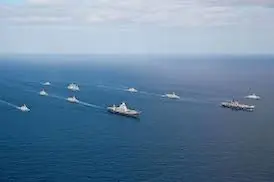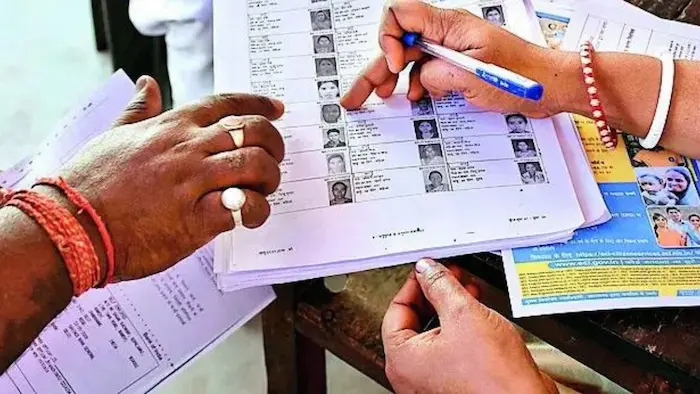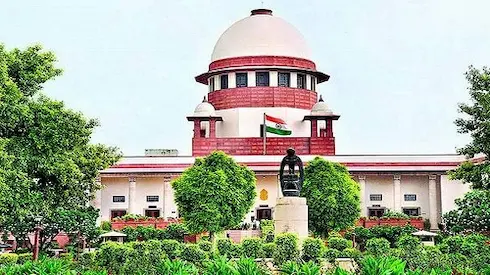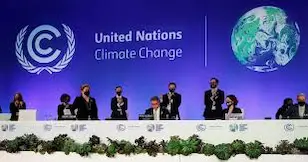1. National Maritime Domain Awareness (NMDA) Project – Defence & Security

Why in News?
The Indian Navy has signed a contract with Bharat Electronics Limited (BEL), Bengaluru, to implement the National Maritime Domain Awareness (NMDA) Project—a critical initiative aimed at strengthening India’s maritime and coastal security.
Key Features of the NMDA Project
| Feature | Description |
|---|---|
| Objective | To create an integrated and intelligent surveillance network for real-time maritime domain awareness. |
| Upgrade of Existing Systems | The NMDA project will upgrade the National Command, Control, Communication, and Intelligence (NC3I) Network. |
| Use of Technology | Incorporates AI-enabled software for better surveillance, data analysis, and decision-making. |
| Lead Integrator | Indian Navy will be the lead agency executing the project on a turnkey basis. |
Institutional Framework & Collaboration
- IMAC Upgradation:
- The Information Management and Analysis Centre (IMAC) in Gurugram will be transformed into a Multi-Agency NMDA Centre.
- It will serve as the central hub for the upgraded NC3I Network.
- Multi-Ministry Collaboration:
- Personnel from 15 agencies across 7 ministries (Defence, Shipping, Petroleum, Fisheries, etc.) will be co-located at the new center.
- Enables real-time coordination and information sharing.
- Unified Maritime Picture:
- Integration of data from coastal states, union territories, and various maritime stakeholders.
- Aims to create a comprehensive operational view of India’s coastline and surrounding seas.
Strategic Importance
- Enhances India’s preparedness to handle:
- Maritime threats
- Search and Rescue (SAR) operations
- Illegal activities such as smuggling, piracy, and terrorism
- Environmental disasters like oil spills
- Integrates data from sectors like commercial shipping and fisheries for holistic monitoring.
- Fulfills key objectives under the Blue Economy and maritime governance frameworks.
Exam Connect – Possible Questions
Prelims
1. The recently launched National Maritime Domain Awareness (NMDA) Project is primarily aimed at:
A. Promoting maritime tourism
B. Enhancing India’s naval export capabilities
C. Strengthening maritime and coastal security through data integration and AI
D. Setting up a new naval base in Andaman and Nicobar
Answer: C. Strengthening maritime and coastal security through data integration and AI
2. Which of the following centers is being upgraded under the NMDA Project?
A. National Disaster Response Centre
B. Information Management and Analysis Centre (IMAC)
C. Indian Coastal Surveillance Hub
D. Marine Intelligence Command Post
Answer: B. Information Management and Analysis Centre (IMAC)
Mains
1. “India’s maritime security architecture is undergoing a transformation with initiatives like the NMDA Project.”
Discuss the strategic significance of the NMDA Project in India’s coastal and maritime security framework. (250 words)
2. Highlight the role of inter-agency coordination and technology in ensuring effective maritime domain awareness. How does the NMDA project align with this approach? (150 words)
2. ‘Neutral Clean-Up’ of Bihar’s Electoral Rolls: A Democratic Concern – Polity

Why in News?
The Election Commission of India (ECI) is conducting a Special Intensive Revision (SIR) of electoral rolls in Bihar, requiring nearly 4.74 crore voters to furnish fresh documentation. This initiative—framed as a move to enhance electoral integrity—has sparked controversy for its potential to disenfranchise large sections of eligible voters, especially from marginalized and rural communities.
Key Takeaways
| Feature | Description |
|---|---|
| Scope | Nearly 4.74 crore voters asked to re-verify their eligibility. |
| Requirement | Submission of new documents like birth certificates, land deeds, or other proofs of residence and age. |
| Impact on Marginalized Groups | Migrant workers (~20% of Bihar’s population), landless laborers, and rural poor face barriers due to lack of documents. |
| Documentation Challenge | Many commonly used government-issued IDs (e.g., Aadhaar, Voter ID) are not accepted as valid proof. |
| Administrative Concerns | Lack of time, infrastructure, and clarity in guidelines poses a threat to inclusiveness and fairness. |
Constitutional & Legal Implications
Fundamental Rights at Risk
- Right to Vote: While not a fundamental right, it is a statutory right integral to democratic participation.
- Article 14 – Equality Before Law: Targeted disenfranchisement or exclusion based on socio-economic status violates equality principles.
- Article 21 – Right to Life with Dignity: Arbitrary removal from voter lists without fair procedure undermines democratic dignity.
- Fraternity & Social Justice (Preamble): The revision may deepen marginalization, contrary to constitutional ideals of fraternity and justice.
Critical Issues Raised
1. Selective Exclusion / Subtle Gerrymandering
- Unlike traditional gerrymandering (redrawing constituency boundaries), this exercise influences electoral outcomes by controlling who is allowed to vote.
2. Erosion of Trust in Electoral Institutions
- Rejecting previously accepted IDs without transparent justification may damage citizens’ faith in the ECI.
3. Legal & Judicial Scrutiny
- The process is under judicial review for potential violations of constitutional safeguards.
Wider Implications for India
- Could set a dangerous precedent for similar revisions in other states.
- Reflects a broader shift toward documentation-heavy citizenship verification, raising alarms seen during the NRC (National Register of Citizens) controversy.
- Risk of transforming voter verification into an exclusionary bureaucratic process.
Exam Connect – Possible Questions
Prelims
1. The Special Intensive Revision (SIR) of electoral rolls, recently in the news, is being carried out in which state?
A. Uttar Pradesh
B. Assam
C. Bihar
D. West Bengal
Answer:C. Bihar
2. Which of the following Articles of the Indian Constitution is most relevant in the context of concerns over exclusion in electoral rolls?
A. Article 17 – Abolition of Untouchability
B. Article 14 – Equality Before Law
C. Article 20 – Protection in respect of conviction
D. Article 32 – Constitutional Remedies
Answer: B. Article 14 – Equality Before Law
Mains
1. The integrity of electoral rolls is essential for a fair democracy, but recent initiatives like the one in Bihar highlight the tension between security and inclusiveness. Critically examine the implications of document-heavy voter verification processes on marginalized communities. (250 words)
3. Panna Tiger Reserve: A Conservation Hotspot in Central India – Environment

Why in News?
Vatsala, Asia’s oldest living elephant, recently passed away at over 100 years of age in the Panna Tiger Reserve, Madhya Pradesh. Her death not only marks the end of a conservation era but also draws attention to the ecological and cultural richness of the reserve.
Key Facts About Panna Tiger Reserve
| Attribute | Details |
|---|---|
| Location | Chhatarpur & Panna districts, Madhya Pradesh |
| Establishment as Tiger Reserve | 1994, under Project Tiger |
| Region | Only Tiger Reserve in the Bundelkhand region |
| Topography | Known for its “Table Top” landscape of plateaus and gorges |
| Area | 542 sq.km, forming part of the Deccan Peninsula biogeographic zone, within the Central Highlands biotic province |
Ecological Features
Landscape & Vegetation
- Dominated by dry deciduous forests and grasslands.
- Northern region: Dense Teak forests.
- Other areas: Mixed forests of Teak and Kardhai (Anogeissus pendula).
- Rich in medicinal plants and ethnobotanical species.
Fauna
- Flagship species: Tiger (Panthera tigris)
- Other major species:
- Leopards
- Sloth Bears
- Striped Hyenas
- Wild Dogs (Dholes)
- Indian Jackals
- Significant birdlife and reptiles also inhabit the reserve.
Cultural & Geographical Significance
- Traversed by the Ken River, which flows south to north.
- Notable for 2,000-year-old rock paintings.
- Inhabited by Baiga and Gond tribes, known for their:
- Sustainable forest practices
- Deep ecological knowledge
- Rich cultural traditions
Conservation Achievements & Challenges
Success Story
- Once declared tiger-less in 2009, Panna successfully reintroduced tigers through translocation efforts, becoming a model for tiger rewilding.
Current Concerns
- Human-animal conflict with local tribes
- River-linking projects (e.g., Ken-Betwa) that threaten ecological balance
- Need for stronger anti-poaching surveillance and tribal integration in conservation
Exam Connect – Possible Questions
Prelims
1. Which river flows through the Panna Tiger Reserve?
A. Chambal
B. Narmada
C. Ken
D. Betwa
Answer: C. Ken
2. The Panna Tiger Reserve is located in which biogeographic zone?
A. Western Ghats
B. Deccan Peninsula
C. Gangetic Plains
D. Trans-Himalayan Region
Answer: B. Deccan Peninsula
3. Vatsala, recently in the news for her death at over 100 years, was:
A. A tigress in Panna Reserve
B. A tribal leader in the Baiga community
C. The oldest recorded elephant in Asia
D. The first translocated tiger in Panna
Answer:C. The oldest recorded elephant in Asia
Mains
1. The successful rewilding of tigers in Panna Tiger Reserve is considered a model for conservation in India. Discuss the ecological and administrative factors behind this success. What challenges remain in balancing conservation with local livelihoods? (250 words)
2. Highlight the role of indigenous communities like the Baigas and Gonds in conserving forest ecosystems. How can they be better integrated into protected area management? (150 words)
4. Looking Inward: Reservation Policy in the Supreme Court’s Non-Judicial Appointments – Polity

Why in News?
For the first time in its history, the Supreme Court of India has introduced a reservation policy for Scheduled Castes (SCs) and Scheduled Tribes (STs) in the hiring and promotion of its non-judicial staff (e.g., assistants, attendants). This move marks a significant step towards institutionalizing social justice within the apex court.
Key Takeaways
| Feature | Description |
|---|---|
| Policy Introduced | 15% reservation for SCs and 7.5% for STs in non-judicial posts. |
| Scope | Applies to administrative staff — not judges — including clerks, assistants, and support personnel. |
| Significance | Bridges the gap between legal principles and internal practices within the judiciary. Promotes social inclusion and representation. |
| Delayed Implementation | Despite endorsing reservation in major judgments like Indra Sawhney (1992) and M. Nagaraj (2006), the SC did not apply similar policies to its own staff until now. |
Contextual Background
Judicial Precedent & Irony
- The Supreme Court has historically upheld affirmative action in public employment and education.
- Yet, it failed to reflect these values within its own administrative structure.
- This inconsistency had long been criticized as institutional hypocrisy.
Challenges and Limitations
Exclusion of Other Groups
- No provision yet for:
- Other Backward Classes (OBCs)
- Persons with Disabilities (PwDs)
- Economically Weaker Sections (EWS)
- Legal ambiguity and absence of a comprehensive reservation framework are major hurdles.
Structural Barriers
- Bureaucratic inertia and lack of institutional leadership delayed reforms.
- Lack of a formal reservation policy for constitutional bodies like the judiciary and Election Commission.
Way Forward
- Codify a comprehensive reservation framework for constitutional and judicial institutions.
- Expand coverage to include OBCs, PwDs, and EWS in line with constitutional provisions.
- Establish oversight mechanisms to track implementation and address institutional inertia.
- Strengthen internal HR policies to align with broader goals of social equity and representation.
Exam Connect – Possible Questions
Prelims
1. Recently, the Supreme Court of India implemented reservations for which of the following categories in its non-judicial staff for the first time?
A. OBCs and EWS
B. SCs and STs
C. Women and PwDs
D. All of the above
Answer: B. SCs and STs
2. In which landmark judgment did the Supreme Court uphold the validity of reservation in promotions, subject to certain conditions?
A. Keshavananda Bharati v. State of Kerala
B. Indra Sawhney v. Union of India
C. M. Nagaraj v. Union of India
D. Maneka Gandhi v. Union of India
Answer: C. M. Nagaraj v. Union of India
Mains
1. The Supreme Court’s decision to implement reservations in its administrative staff is both symbolic and substantive. Discuss how this move contributes to internal reform and broader ideals of social justice. Also evaluate the gaps that still persist. (250 words)
2. “Institutions that uphold the Constitution must also internalize its values.” Critically analyze this statement in the context of reservation policies in constitutional bodies like the judiciary. (150 words)
5. RECLAIM Framework: A Blueprint for Inclusive and Sustainable Mine Closure – Economy
Why in News?
The Ministry of Coal has launched the RECLAIM Framework to promote inclusive, sustainable, and accountable coal mine closures. Developed by the Coal Controller Organisation in collaboration with the Heartfulness Institute, this initiative addresses community welfare, environmental restoration, and economic transition in coal-dependent regions.
Key Objectives of the RECLAIM Framework
| Goal | Description |
|---|---|
| Inclusive Mine Closure | Ensure community participation, particularly of women and vulnerable groups. |
| Sustainability | Promote environmental safety, post-mining land repurposing, and livelihood restoration. |
| Institutional Accountability | Align efforts with Panchayati Raj Institutions (PRIs) for local governance and monitoring. |
Background: Evolution of Mine Closure Policy
| Year | Policy Milestone |
|---|---|
| 2009 | First mine closure guidelines issued by the Ministry of Coal. |
| 2013 & 2020 | Revised guidelines with focus on social impact, environmental management, and compliance monitoring. |
Key Features of the RECLAIM Framework
1. Community-Centric Planning
- Conduct need assessments.
- Ensure local stakeholder participation in closure and repurposing.
2. Phased Implementation
- Pre-Closure Phase: Community engagement, skill development, and capacity building.
- Closure Phase: Participatory execution of closure, including environmental mitigation.
- Post-Closure Phase: Focus on:
- Livelihood restoration
- Monitoring and auditing
- Asset repurposing (e.g., eco-tourism, renewable energy)
3. Context-Specific Tools
- Provides practical templates, guidelines, and checklists adapted to Indian mining conditions.
Broader Significance
- Supports India’s Sustainable Development Goals (SDGs), particularly:
- SDG 8: Decent work and economic growth
- SDG 13: Climate action
- SDG 15: Life on land
- Can be adapted to other resource-intensive sectors (e.g., stone quarrying, mineral mining)
Challenges to Effective Implementation
| Challenge | Description |
|---|---|
| Policy–Practice Gap | Since 2009, only 3 coal mines have been formally closed. |
| Low Compliance | Out of 299 non-operational mines, only 8 have started formal closures. |
| Environmental Risks | Abandoned mines emit methane and cause ecological degradation. |
| Social Displacement | Lack of rehabilitation for displaced communities. |
| Land Return Ambiguity | No clear policy for returning post-mining land to original owners or local communities. |
| Financial Barriers | High escrow requirements deter private operators from initiating closure. |
Exam Connect – Possible Questions
Prelims
1. The recently launched RECLAIM Framework is related to:
A. Renewable energy deployment
B. Financial inclusion for rural women
C. Inclusive and sustainable mine closure
D. Reform of urban land ceiling laws
Answer: C. Inclusive and sustainable mine closure
2. Which of the following correctly represents the phased implementation structure of the RECLAIM Framework?
A. Planning – Execution – Monitoring
B. Assessment – Closure – Privatization
C. Pre-Closure – Closure – Post-Closure
D. Survey – Mining – Cleanup
Answer: C. Pre-Closure – Closure – Post-Closure
3. Which institution partnered with the Coal Controller Organisation to develop the RECLAIM Framework?
A. TERI
B. Heartfulness Institute
C. National Institute of Mining
D. WWF India
Answer: B. Heartfulness Institute
Mains
1. “Mine closures in India have long lacked social and environmental accountability.” Examine how the RECLAIM Framework seeks to address these gaps. What are the key challenges in implementing inclusive mine closure in India? (250 words)
2. Discuss the role of Panchayati Raj Institutions in ensuring equitable outcomes during mine closure and land repurposing under the RECLAIM Framework. (150 words)
6. Reforming the UNFCCC: Tackling the Crisis in Global Climate Negotiations – Environment

Why in News?
The UN Framework Convention on Climate Change (UNFCCC) is facing a credibility crisis, especially regarding climate justice, financial commitments, and inclusive participation. As the host of COP30, Brazil has put forward a set of reform proposals to restore global trust in the process.
About the UNFCCC
| Feature | Description |
|---|---|
| Established | 1992 at the Earth Summit in Rio de Janeiro |
| Entered into Force | March 21, 1994 |
| Parties | 198 countries as of 2022 |
| Main Body | Conference of the Parties (COP) – meets annually |
| Primary Objective | To stabilize greenhouse gas concentrations in the atmosphere and avoid dangerous climate change |
Current Crisis in the UNFCCC Process
Key Structural Challenges
- Unmet Commitments by Developed Countries:
- Failure to meet emission reduction targets
- Falling short on the promised $100 billion annual climate finance
- Marginalization of Developing Countries:
- Small Island Developing States (SIDS) and Least Developed Countries (LDCs) often sidelined
- Negotiations dominated by wealthier, larger delegations
- Erosion of Trust:
- U.S. withdrawal from the Paris Agreement under the Trump administration undermined faith in multilateralism
- Perception of the UNFCCC as slow and ineffective
Brazil’s Reform Agenda (Ahead of COP30)
30-Point Reform Plan Highlights
| Reform Area | Proposal |
|---|---|
| Efficiency | Remove overlapping agenda items, shorten negotiation periods |
| Equity | Limit delegation sizes to prevent domination by rich nations |
| Host Country Eligibility | Propose a moratorium on fossil-fuel-reliant countries hosting COPs |
| Mainstreaming | Promote climate negotiations in other global forums like G20, BRICS, etc. |
| Civil Society Role | Advocate for greater transparency, reduce fossil fuel lobby influence |
The Climate Finance Gap
- Developed nations pledged $100 billion annually under the Paris Agreement (2015) to support climate action in developing countries.
- Actual disbursal has been far below the target, creating:
- Delays in climate adaptation projects
- Reduced trust and participation from developing nations
- Calls for:
- Simplified access to climate funds
- Creation of loss and damage financing mechanisms
Civil Society’s Role
- Demand greater accountability and inclusion of vulnerable voices
- Push for a restructured COP format to ensure fair representation
- Campaign against fossil fuel lobbying within climate negotiations
Way Forward: Can the UNFCCC Be Fixed?
Challenges:
- Entrenched interests of developed countries
- Lack of political will for deep structural reform
- Fragmentation of multilateral climate governance
Opportunities:
- Brazil’s proactive leadership at COP30
- Rising global awareness on climate justice
- Greater South-South cooperation on environmental policy
Exam Connect – Possible Questions
Prelims
1. The UN Framework Convention on Climate Change (UNFCCC) was adopted at which summit?
A. Kyoto Protocol Summit
B. Earth Summit, Rio de Janeiro
C. Stockholm Conference
D. Paris Climate Summit
Answer: B. Earth Summit, Rio de Janeiro
2. Which of the following countries is hosting COP30 and leading a reform initiative for the UNFCCC process?
A. India
B. Germany
C. Brazil
D. South Africa
Answer: C. Brazil
3. Under the Paris Agreement, developed countries are expected to provide how much climate finance annually to developing nations?
A. $50 billion
B. $100 billion
C. $250 billion
D. $10 billion
Answer: B. $100 billion
Mains
1. The UNFCCC, despite being a key institution for climate negotiations, faces a growing credibility crisis.
Discuss the structural challenges within the UNFCCC framework and critically evaluate Brazil’s proposed reforms ahead of COP30. (250 words)
2. What role can developing countries and civil society play in ensuring equitable climate negotiations at global forums like COP? (150 words)

